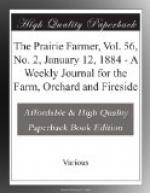The cost of buckthorn hedges, including the preparation of a strip of soil five feet wide, purchase of plants, setting, and occasional horse cultivation on each side, was about twenty-five cents a rod the first year. The yearly cultivation and cutting back, until the hedge had reached full size, was three or four cents a rod. Though the buckthorn has nearly passed out of use on account of its inefficiency, it is not impossible that it may be extensively planted when cultivators find that it may be converted into an efficient barrier by inclosing two or three barbed wires extending its length through the interior—these wires, supported on occasional posts, being successively placed in position as the hedge increases in height, the branches growing around the wires and holding them immovably in position. Galvanized wire should be always used, on account of its durability.
Osage orange hedges require more care than buckthorn, in assorting plants of equal size and vigor, and the rejection of feeble plants. Like all other hedge plants, they should be set in a single line, and eight inches apart is a suitable distance. For the first few years the ground must be kept well cultivated. It is partly tender and will not endure the winters at the North, unless on a well-drained soil. Hence the importance of placing a good tile drain parallel to the hedge and within a few feet of it. Thus protected, good hedges have stood for twenty-five years where the thermometer has often shown ten or twelve degrees below zero, and sometimes lower.
No hedge is more commonly mismanaged than the Osage orange. It is planted in imperfectly prepared ground; vigorous and feeble plants are planted indiscriminately, cultivation and pruning are omitted or not done thoroughly, resulting in broken and irregular lines. When more care is given, the hedge is nearly spoiled by being pruned too wide at the top, the heavy shade above causing meagre growth and openings below. It should be pruned in wedge shape, but shearing is objectionable as causing a thick and short growth of leaves at the exterior, excluding light from the inside and causing bare branches there. Cutting back more irregularly with a knife allows the growth of interior foliage, and gives more breadth to the hedge. The sheared hedge presents an unnatural stiffness in ornamental grounds; but skillfully cut back with the knife it has more of the beauty of natural form. The manner of pruning is very important, both as regards utility and beauty. For farm barriers hedges do not require so elaborate care. Another mode of treatment has been adopted in the Western States. The trees are trimmed and the main stems trained upright for a few years. They are then cut half off at the ground and bent over at an angle of thirty degrees with the ground, a tree being left upright at distances of four or five feet, and the inclined ones interwoven among them, a straight line of trees being thus formed. The tops are then cut off about three feet high. New shoots spring up in abundance and form an impenetrable growth, as many as fifty having been counted from a single plant the first year. The top is cut to within a few inches each year of its previous height. Hedges made in this way have no gaps.




